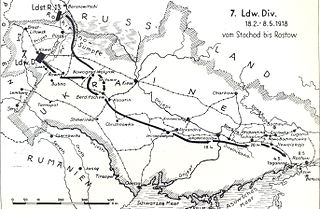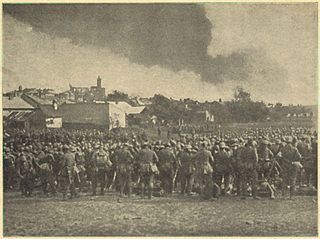Sources
This article includes a list of references, related reading, or external links, but its sources remain unclear because it lacks inline citations .(January 2016) |
| 215th Infantry Division (215. Infanterie-Division) | |
|---|---|
| Active | 8 September 1916 to 16 March 1919 |
| Country | German Empire |
| Branch | Army |
| Type | Infantry |
| Size | Approx. 15,000 |
| Engagements | World War I
|
The 215th Infantry Division (German: 215. Infanterie-Division) was a unit in the German Imperial Army during World War I. Created in September 1916, it primarily saw service on the Eastern Front and in Ukraine.
1916
1917
1918
1919
This article includes a list of references, related reading, or external links, but its sources remain unclear because it lacks inline citations .(January 2016) |
The Alpenkorps was a provisional mountain formation of division size formed by the Imperial German Army during World War I. It was considered by the Allies to be one of the best in the German Army.

The 7th Landwehr Division was a unit of the Prussian/German Army. The division was formed on January 27, 1915, out of two formerly Mixed Landwehr Brigades. The division spent the period from its formation to early 1917 on the Western Front, mainly involved in positional warfare in Upper Alsace, after which it went to the Lorraine front. It was transferred to the Eastern Front in the Spring of 1917, where it remained after the 1917 armistice on that front. In 1918, it served on internal security missions in Ukraine, where it was located when World War I ended. Allied intelligence rated the division as a fourth class division. The division was disbanded in 1919, during the demobilization of the German Army after World War I.
The 35th Reserve Division was a unit of the Imperial German Army in World War I. The division was formed on the mobilization of the German Army in August 1914. The division was disbanded during the demobilization of the German Army after World War I. The division began the war as part of the central reserve of Fortress Thorn. Although designated a reserve division, initially, it was primarily composed of Landwehr units. In 1916, it was completely reorganized, receiving new brigade headquarters and newly formed regiments.
The 33rd Reserve Division was a unit of the Imperial German Army, in World War I. The division was formed on the mobilization of the German Army in August 1914. The division was disbanded in August 1918. The division began the war as part of the central reserve of Fortress Metz.
The Royal Saxon 23rd Reserve Division was a unit of the Imperial German Army in World War I. The division was formed on mobilization of the German Army in August 1914 as part of the XII Reserve Corps. The division was raised in the Kingdom of Saxony and was disbanded in 1919 during the demobilization of the German Army after World War I.
The 15th Reserve Division was a unit of the Prussian Army within the Imperial German Army in World War I. The division was formed on mobilization of the German Army in August 1914 as part of VIII Reserve Corps. The division was disbanded in 1919 during the demobilization of the German Army after World War I. The division was recruited primarily in the Prussian Rhine Province. At the beginning of the war, it formed the VIII Reserve Corps with the 16th Reserve Division.
The 43rd Reserve Division was a unit of the Imperial German Army in World War I. The division was formed in August 1914 and organized over the next two months. It was part of the first wave of new divisions formed at the outset of World War I, which were numbered the 43rd through 54th Reserve Divisions. The division was disbanded in 1918 and its assets redistributed to other divisions. The division was part of the XXII Reserve Corps and was raised through the depots of the elite Prussian Guard, and thus recruited throughout Prussia.
The 48th Reserve Division was a unit of the Imperial German Army in World War I. The division was formed in September 1914 and organized over the next month, arriving in the line in October. It was part of the first wave of new divisions formed at the outset of World War I, which were numbered the 43rd through 54th Reserve Divisions. The division was part of XXIV Reserve Corps. It was disbanded in 1919 during the demobilization of the German Army after World War I.
The 53rd Reserve Division was a unit of the Imperial German Army in World War I. The division was formed in September 1914 and organized over the next month, arriving in the line in October. It was part of the first wave of new divisions formed at the outset of World War I, which were numbered the 43rd through 54th Reserve Divisions. The division was initially part of XXVII Reserve Corps. The division was disbanded in September 1918 and its assets distributed to other units. The division was recruited in the Kingdom of Saxony.

The 3rd Landwehr Division was an infantry division of the Imperial German Army during World War I. It was formed on the mobilization of the German Army in August 1914 under the "Higher Landwehr Commander 3". The Landwehr was the third category of the German Army, after the regular Army and the reserves. Thus Landwehr divisions were made up of older soldiers who had passed from the reserves, and were intended primarily for occupation and security duties rather than heavy combat. While the division was a Landwehr formation, at the beginning of the war it also had an attached Ersatz infantry brigade, made up of cadres from various regimental replacement battalions. The division was primarily raised in the Prussian provinces of Posen, Lower Silesia, and West Prussia. The division was disbanded in 1919 during the demobilization of the German Army after World War I.

The 4th Landwehr Division was an infantry division of the Imperial German Army during World War I. It was formed on mobilization of the German Army in August 1914 under the "Higher Landwehr Commander 4". The Landwehr was the third category of the German Army, after the regular Army and the reserves. Thus Landwehr divisions were made up of older soldiers who had passed from the reserves, and were intended primarily for occupation and security duties rather than heavy combat. The division was primarily raised in the Prussian provinces of Upper and Lower Silesia. It was disbanded in 1919 during the demobilization of the German Army after World War I.
The 121st Infantry Division was a formation of the Imperial German Army in World War I. The division was formed on March 25, 1915, and organized over the next several weeks. It was part of a wave of new infantry divisions formed in the spring of 1915. The division was disbanded in 1919, during the demobilization of the German Army after World War I.
The 10th Bavarian Infantry Division was a unit of the Royal Bavarian Army, part of the Imperial German Army, in World War I. The division was formed on March 3, 1915, and organized over the next few weeks. It was part of a wave of new infantry divisions formed in the spring of 1915. The division was disbanded in August 1918 and its assets distributed to other units.
The 108th Infantry Division was a formation of the Imperial German Army in World War I. The division was formed in May 1915 as "Division Beckmann" and became the 108th Infantry Division on November 7, 1915. It was part of a wave of new infantry divisions formed in 1915. The division was disbanded in September 1918 and its assets distributed to other units.
The 109th Infantry Division was a formation of the Imperial German Army in World War I. The division was formed in November 1915. It was the last of a wave of new infantry divisions formed in 1915. The division was disbanded in August 1918 and its assets distributed to other units.
The 84th Infantry Division was a formation of the Imperial German Army in World War I. The division was formed in November 1914 as the "Division Posen 2", part of the Posen Corps, and became the 84th Infantry Division in June 1915. It was initially formed from the garrison infantry regiments of Fortress Posen. The division was disbanded in 1919 during the demobilization of the German Army after World War I.
The 85th Landwehr Division was a unit of the Imperial German Army in World War I. The division was formed in November 1914 as the Breugel Division, named after its commander, Generalleutnant Willem Hendrick Clifford Kocq von Breugel, and became the 85th Landwehr Division on 13 September 1915. The division was disbanded in 1919 during the demobilization of the German Army after World War I. The Landwehr was the third category of the German Army, after the regular Army and the reserves. Thus Landwehr divisions were generally made up of older soldiers who had passed from the reserves, and were intended primarily for occupation and security duties rather than heavy combat.
The 86th Infantry Division was a formation of the Imperial German Army in World War I. The division was formed in November 1914 as the Wernitz Division, named after its commander General Theodor von Wernitz, and became the 86th Infantry Division in August 1915. The division was disbanded in 1919 during the demobilization of the German Army after World War I.
The 88th Infantry Division was a formation of the Imperial German Army in World War I. The division was formed in November 1914 as the Menges Division, named after its commander, and made up primarily of Landwehr troops. It became the 88th Infantry Division in August 1915. The division was disbanded in 1919 during the demobilization of the German Army after World War I.
The 95th Infantry Division was a formation of the Imperial German Army in World War I.